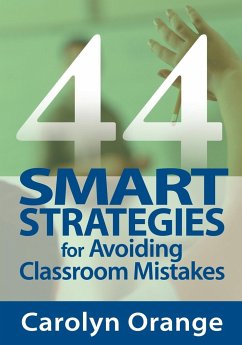Carolyn Orange
44 Smart Strategies for Avoiding Classroom Mistakes
Carolyn Orange
44 Smart Strategies for Avoiding Classroom Mistakes
- Broschiertes Buch
- Merkliste
- Auf die Merkliste
- Bewerten Bewerten
- Teilen
- Produkt teilen
- Produkterinnerung
- Produkterinnerung
Based on the observations of more than 200 instructors, this hands-on text presents finely honed strategies to help teachers create an environment for better teaching and learning.
Andere Kunden interessierten sich auch für
![Towards a Fail-Safe Air Force Culture: Creating a Resilient Future While Avoiding Past Mistakes Towards a Fail-Safe Air Force Culture: Creating a Resilient Future While Avoiding Past Mistakes]() Todd Ericson\Towards a Fail-Safe Air Force Culture: Creating a Resilient Future While Avoiding Past Mistakes54,99 €
Todd Ericson\Towards a Fail-Safe Air Force Culture: Creating a Resilient Future While Avoiding Past Mistakes54,99 €![Avoiding the Curtain's Shadow: Pragmatic Engagement in US-Russian Relations Avoiding the Curtain's Shadow: Pragmatic Engagement in US-Russian Relations]() Ethan C. GriffinAvoiding the Curtain's Shadow: Pragmatic Engagement in US-Russian Relations58,99 €
Ethan C. GriffinAvoiding the Curtain's Shadow: Pragmatic Engagement in US-Russian Relations58,99 €![Smart Tankers: A Theory for Multi-Tasking Aircraft Smart Tankers: A Theory for Multi-Tasking Aircraft]() Martin R. HertzSmart Tankers: A Theory for Multi-Tasking Aircraft58,99 €
Martin R. HertzSmart Tankers: A Theory for Multi-Tasking Aircraft58,99 €![CUTE AND SMART CUTE AND SMART]() Carol L. KuglerCUTE AND SMART25,99 €
Carol L. KuglerCUTE AND SMART25,99 €![Mathematische Annalen; Volume 44 Mathematische Annalen; Volume 44]() Albert EinsteinMathematische Annalen; Volume 4430,99 €
Albert EinsteinMathematische Annalen; Volume 4430,99 €![Secured Smart Voting System Using Aadhaar Secured Smart Voting System Using Aadhaar]() Bharathi SSecured Smart Voting System Using Aadhaar12,99 €
Bharathi SSecured Smart Voting System Using Aadhaar12,99 €![Information Security: Securing Smart Cards with Iris Recognition Information Security: Securing Smart Cards with Iris Recognition]() Orval E. PhelpsInformation Security: Securing Smart Cards with Iris Recognition58,99 €
Orval E. PhelpsInformation Security: Securing Smart Cards with Iris Recognition58,99 €-
-
-
Based on the observations of more than 200 instructors, this hands-on text presents finely honed strategies to help teachers create an environment for better teaching and learning.
Produktdetails
- Produktdetails
- Verlag: Corwin
- Seitenzahl: 242
- Erscheinungstermin: 7. Dezember 2004
- Englisch
- Abmessung: 254mm x 178mm x 13mm
- Gewicht: 463g
- ISBN-13: 9780761938750
- ISBN-10: 0761938753
- Artikelnr.: 21695337
- Herstellerkennzeichnung
- Libri GmbH
- Europaallee 1
- 36244 Bad Hersfeld
- gpsr@libri.de
- Verlag: Corwin
- Seitenzahl: 242
- Erscheinungstermin: 7. Dezember 2004
- Englisch
- Abmessung: 254mm x 178mm x 13mm
- Gewicht: 463g
- ISBN-13: 9780761938750
- ISBN-10: 0761938753
- Artikelnr.: 21695337
- Herstellerkennzeichnung
- Libri GmbH
- Europaallee 1
- 36244 Bad Hersfeld
- gpsr@libri.de
Carolyn Orange is Professor of Educational Psychology at the University of Texas at San Antonio. She teaches Psychological Basis of Learning, Learning and Development of the School Age Child, Human Growth and Development, and Psychology of Human Motivation. She has a PhD and Master of Arts degree in Educational Psycho logy from Washington University and a Bachelor of Arts degree from Harris Stowe State College. She began her teaching career in the St. Louis Public Schools where she taught for a number of years. Her work as an educator has spanned about 25 years. That period includes some time that she worked for two corporations. She has worked as a researcher and educator in a variety of educational settings: elementary, secondary, English as a Second Language (ESL), Montessori, special education, adult education, art, and higher education. She has produced a video on self-regulation and has developed a Self-Regulation Inventory. She has published numerous articles in journals such as the Journal of Adolescent and Adult Literacy, The Journal of Experimental Education, The Roeper Review, Journal of Communications and Minority Issues, The Journal of Black Studies, The NASSP: Curriculum Report, and The High School Journal. In 2001, she was appointed to the review board of the Journal of Communications and Minority Issues. She is on the Board of Directors for the Girl Scout Council of San Antonio. She was included in Who's Who in the World for 2005; Who's Who Among American Teachers for 1996, 1998, 2000, 2002, and 2003; Who's Who in America 2001, 2002, and 2003/2004. Her current research interests are envirosocial factors that affect student achievement. She is the author of 25 Biggest Mistakes Teachers Make and How to Avoid Them (2000) and Quick Reference Guide to Educational Innovations: xiv FM-Orange.qxd 11/12/2004 4:21 PM Page xv About the Author xv Practices, Programs, Policies and Philosophies (2002). 25 Biggest Mistakes Teachers Make and How to Avoid Them is a bestseller and has gained worldwide popularity. It has been reviewed in India and translated into Thai, Chinese, and Slovenian. She was inducted into the San Antonio Women's Hall of Fame in 2004.
Preface
Introduction
Acknowledgments
About the Author
Section 1: Expect the Unexpected
Smart Strategy 1: Those Who Fail to Plan, Plan to Fail
Smart Strategy 2: Develop Your Academic Sixth Sense
Section 2: The Organized Classroom
Smart Strategy 3: Create the Well-Oiled Machine That Runs on Its Own
Smart Strategy 4: Harness the Paper Tiger
Smart Strategy 5: Design Soul-Stirring Learning Environments
Smart Strategy 6: Creative Minds Can Be Tidy
Section 3: Become a Friend of the Family
Smart Strategy 7: Seek Parents as Partners
Smart Strategy 8: Promote Parent Involvement Through Active Interaction
Smart Stragegy 9: Use a Sandwich Cookie Model of Parent Conferencing
Smart Strategy 10: Make House Calls
Section 4: Raise Your Nurturance Index a Notch or Two
Smart Strategy 11: Love the Unlovable Child
Smart Strategy 12: Seek to Understand All of Your Children
Smart Strategy 13: Consider Special Ethnicity and Cultural Issues
Smart Strategy 14: Respect and Celebrate Student Differences
Smart Strategy 15: Avoid Academic Trauma
Smart Strategy 16: Empower the Disempowered
Smart Strategy 17: Practice Saying Yes Whenever Possible
Section 5: Balance Your Personal Assets and Liabilities
Smart Strategy 18: Develop Strategies to Maximize Your Strengths and
Minimize Your Weaknesses
Smart Strategy 19: Shelve Your Emotional Baggage
Smart Strategy 20: Use All of Your Talents
Section 6: Teach With a Slow Hand and a Gentle Touch
Smart Strategy 21: Model and Expect Good Behavior From All Children
Smart Strategy 22: Courtesy Is Contagious
Smart Strategy 23: Make Punishment a Last Resort
Smart Strategy 24: Be a Gentle Critic
Smart Strategy 25: Treat Children the Way You Treat Adults
Smart Strategy 26: Be a Promoter of Positive Behavior
Smart Strategy 27: Use Logical Appeal as a Discipline Strategy
Smart Strategy 28: Catch Bees With Honey Not Vinegar
Section 7: Be an Edutainer: Educator + Entertainer
Smart Strategy 29: Put Some Pep in Your Academic Step
Smart Strategy 30: Pump Up the Volume of Student Participation
Smart Strategy 31: Be Passionate About Pedagogy
Smart Strategy 32: Strut Your Stuff
Section 8: Do a Three-Step to an Instructional Beat
Smart Strategy 33: Conduct Your Own Diagnostic Clinic: Ascertain and Assess
Student Skills and Weaknesses
Smart Strategy 34: Prescribe an Effective Personalized Action Plan
Smart Strategy 35: Promote Implementation of the Plan and Self-Regulated
Learning
Section 9: Seek to Inspire and Motivate
Smart Strategy 36: Start With Yourself: Self-Motivate
Smart Strategy 37: Showcase Each Child¿s Talents: Tap Into Multiple
Intelligences
Smart Strategy 38: Rewrite an Ineffective Classroom Script
Smart Strategy 39: Avoid Burnout: Rekindle the Joy of Teaching
Smart Strategy 40: Teach Children to Love Learning
Smart Strategy 41: Move Your Class to Action Through Discovery and Inquiry
Smart Strategy 42: Take Your Children to Water and Make Them Want to Drink
Section 10: Do a Professional Makeover
Smart Strategy 43: Project a Professional Image: Avoid the Blue Jeans and
Sneakers Trap
Smart Strategy 44: Perfect Your Teacher Voice and Educator Countenance:
Develop a Get-Down-to-Business Demeanor
References
Index
Introduction
Acknowledgments
About the Author
Section 1: Expect the Unexpected
Smart Strategy 1: Those Who Fail to Plan, Plan to Fail
Smart Strategy 2: Develop Your Academic Sixth Sense
Section 2: The Organized Classroom
Smart Strategy 3: Create the Well-Oiled Machine That Runs on Its Own
Smart Strategy 4: Harness the Paper Tiger
Smart Strategy 5: Design Soul-Stirring Learning Environments
Smart Strategy 6: Creative Minds Can Be Tidy
Section 3: Become a Friend of the Family
Smart Strategy 7: Seek Parents as Partners
Smart Strategy 8: Promote Parent Involvement Through Active Interaction
Smart Stragegy 9: Use a Sandwich Cookie Model of Parent Conferencing
Smart Strategy 10: Make House Calls
Section 4: Raise Your Nurturance Index a Notch or Two
Smart Strategy 11: Love the Unlovable Child
Smart Strategy 12: Seek to Understand All of Your Children
Smart Strategy 13: Consider Special Ethnicity and Cultural Issues
Smart Strategy 14: Respect and Celebrate Student Differences
Smart Strategy 15: Avoid Academic Trauma
Smart Strategy 16: Empower the Disempowered
Smart Strategy 17: Practice Saying Yes Whenever Possible
Section 5: Balance Your Personal Assets and Liabilities
Smart Strategy 18: Develop Strategies to Maximize Your Strengths and
Minimize Your Weaknesses
Smart Strategy 19: Shelve Your Emotional Baggage
Smart Strategy 20: Use All of Your Talents
Section 6: Teach With a Slow Hand and a Gentle Touch
Smart Strategy 21: Model and Expect Good Behavior From All Children
Smart Strategy 22: Courtesy Is Contagious
Smart Strategy 23: Make Punishment a Last Resort
Smart Strategy 24: Be a Gentle Critic
Smart Strategy 25: Treat Children the Way You Treat Adults
Smart Strategy 26: Be a Promoter of Positive Behavior
Smart Strategy 27: Use Logical Appeal as a Discipline Strategy
Smart Strategy 28: Catch Bees With Honey Not Vinegar
Section 7: Be an Edutainer: Educator + Entertainer
Smart Strategy 29: Put Some Pep in Your Academic Step
Smart Strategy 30: Pump Up the Volume of Student Participation
Smart Strategy 31: Be Passionate About Pedagogy
Smart Strategy 32: Strut Your Stuff
Section 8: Do a Three-Step to an Instructional Beat
Smart Strategy 33: Conduct Your Own Diagnostic Clinic: Ascertain and Assess
Student Skills and Weaknesses
Smart Strategy 34: Prescribe an Effective Personalized Action Plan
Smart Strategy 35: Promote Implementation of the Plan and Self-Regulated
Learning
Section 9: Seek to Inspire and Motivate
Smart Strategy 36: Start With Yourself: Self-Motivate
Smart Strategy 37: Showcase Each Child¿s Talents: Tap Into Multiple
Intelligences
Smart Strategy 38: Rewrite an Ineffective Classroom Script
Smart Strategy 39: Avoid Burnout: Rekindle the Joy of Teaching
Smart Strategy 40: Teach Children to Love Learning
Smart Strategy 41: Move Your Class to Action Through Discovery and Inquiry
Smart Strategy 42: Take Your Children to Water and Make Them Want to Drink
Section 10: Do a Professional Makeover
Smart Strategy 43: Project a Professional Image: Avoid the Blue Jeans and
Sneakers Trap
Smart Strategy 44: Perfect Your Teacher Voice and Educator Countenance:
Develop a Get-Down-to-Business Demeanor
References
Index
Preface
Introduction
Acknowledgments
About the Author
Section 1: Expect the Unexpected
Smart Strategy 1: Those Who Fail to Plan, Plan to Fail
Smart Strategy 2: Develop Your Academic Sixth Sense
Section 2: The Organized Classroom
Smart Strategy 3: Create the Well-Oiled Machine That Runs on Its Own
Smart Strategy 4: Harness the Paper Tiger
Smart Strategy 5: Design Soul-Stirring Learning Environments
Smart Strategy 6: Creative Minds Can Be Tidy
Section 3: Become a Friend of the Family
Smart Strategy 7: Seek Parents as Partners
Smart Strategy 8: Promote Parent Involvement Through Active Interaction
Smart Stragegy 9: Use a Sandwich Cookie Model of Parent Conferencing
Smart Strategy 10: Make House Calls
Section 4: Raise Your Nurturance Index a Notch or Two
Smart Strategy 11: Love the Unlovable Child
Smart Strategy 12: Seek to Understand All of Your Children
Smart Strategy 13: Consider Special Ethnicity and Cultural Issues
Smart Strategy 14: Respect and Celebrate Student Differences
Smart Strategy 15: Avoid Academic Trauma
Smart Strategy 16: Empower the Disempowered
Smart Strategy 17: Practice Saying Yes Whenever Possible
Section 5: Balance Your Personal Assets and Liabilities
Smart Strategy 18: Develop Strategies to Maximize Your Strengths and
Minimize Your Weaknesses
Smart Strategy 19: Shelve Your Emotional Baggage
Smart Strategy 20: Use All of Your Talents
Section 6: Teach With a Slow Hand and a Gentle Touch
Smart Strategy 21: Model and Expect Good Behavior From All Children
Smart Strategy 22: Courtesy Is Contagious
Smart Strategy 23: Make Punishment a Last Resort
Smart Strategy 24: Be a Gentle Critic
Smart Strategy 25: Treat Children the Way You Treat Adults
Smart Strategy 26: Be a Promoter of Positive Behavior
Smart Strategy 27: Use Logical Appeal as a Discipline Strategy
Smart Strategy 28: Catch Bees With Honey Not Vinegar
Section 7: Be an Edutainer: Educator + Entertainer
Smart Strategy 29: Put Some Pep in Your Academic Step
Smart Strategy 30: Pump Up the Volume of Student Participation
Smart Strategy 31: Be Passionate About Pedagogy
Smart Strategy 32: Strut Your Stuff
Section 8: Do a Three-Step to an Instructional Beat
Smart Strategy 33: Conduct Your Own Diagnostic Clinic: Ascertain and Assess
Student Skills and Weaknesses
Smart Strategy 34: Prescribe an Effective Personalized Action Plan
Smart Strategy 35: Promote Implementation of the Plan and Self-Regulated
Learning
Section 9: Seek to Inspire and Motivate
Smart Strategy 36: Start With Yourself: Self-Motivate
Smart Strategy 37: Showcase Each Child¿s Talents: Tap Into Multiple
Intelligences
Smart Strategy 38: Rewrite an Ineffective Classroom Script
Smart Strategy 39: Avoid Burnout: Rekindle the Joy of Teaching
Smart Strategy 40: Teach Children to Love Learning
Smart Strategy 41: Move Your Class to Action Through Discovery and Inquiry
Smart Strategy 42: Take Your Children to Water and Make Them Want to Drink
Section 10: Do a Professional Makeover
Smart Strategy 43: Project a Professional Image: Avoid the Blue Jeans and
Sneakers Trap
Smart Strategy 44: Perfect Your Teacher Voice and Educator Countenance:
Develop a Get-Down-to-Business Demeanor
References
Index
Introduction
Acknowledgments
About the Author
Section 1: Expect the Unexpected
Smart Strategy 1: Those Who Fail to Plan, Plan to Fail
Smart Strategy 2: Develop Your Academic Sixth Sense
Section 2: The Organized Classroom
Smart Strategy 3: Create the Well-Oiled Machine That Runs on Its Own
Smart Strategy 4: Harness the Paper Tiger
Smart Strategy 5: Design Soul-Stirring Learning Environments
Smart Strategy 6: Creative Minds Can Be Tidy
Section 3: Become a Friend of the Family
Smart Strategy 7: Seek Parents as Partners
Smart Strategy 8: Promote Parent Involvement Through Active Interaction
Smart Stragegy 9: Use a Sandwich Cookie Model of Parent Conferencing
Smart Strategy 10: Make House Calls
Section 4: Raise Your Nurturance Index a Notch or Two
Smart Strategy 11: Love the Unlovable Child
Smart Strategy 12: Seek to Understand All of Your Children
Smart Strategy 13: Consider Special Ethnicity and Cultural Issues
Smart Strategy 14: Respect and Celebrate Student Differences
Smart Strategy 15: Avoid Academic Trauma
Smart Strategy 16: Empower the Disempowered
Smart Strategy 17: Practice Saying Yes Whenever Possible
Section 5: Balance Your Personal Assets and Liabilities
Smart Strategy 18: Develop Strategies to Maximize Your Strengths and
Minimize Your Weaknesses
Smart Strategy 19: Shelve Your Emotional Baggage
Smart Strategy 20: Use All of Your Talents
Section 6: Teach With a Slow Hand and a Gentle Touch
Smart Strategy 21: Model and Expect Good Behavior From All Children
Smart Strategy 22: Courtesy Is Contagious
Smart Strategy 23: Make Punishment a Last Resort
Smart Strategy 24: Be a Gentle Critic
Smart Strategy 25: Treat Children the Way You Treat Adults
Smart Strategy 26: Be a Promoter of Positive Behavior
Smart Strategy 27: Use Logical Appeal as a Discipline Strategy
Smart Strategy 28: Catch Bees With Honey Not Vinegar
Section 7: Be an Edutainer: Educator + Entertainer
Smart Strategy 29: Put Some Pep in Your Academic Step
Smart Strategy 30: Pump Up the Volume of Student Participation
Smart Strategy 31: Be Passionate About Pedagogy
Smart Strategy 32: Strut Your Stuff
Section 8: Do a Three-Step to an Instructional Beat
Smart Strategy 33: Conduct Your Own Diagnostic Clinic: Ascertain and Assess
Student Skills and Weaknesses
Smart Strategy 34: Prescribe an Effective Personalized Action Plan
Smart Strategy 35: Promote Implementation of the Plan and Self-Regulated
Learning
Section 9: Seek to Inspire and Motivate
Smart Strategy 36: Start With Yourself: Self-Motivate
Smart Strategy 37: Showcase Each Child¿s Talents: Tap Into Multiple
Intelligences
Smart Strategy 38: Rewrite an Ineffective Classroom Script
Smart Strategy 39: Avoid Burnout: Rekindle the Joy of Teaching
Smart Strategy 40: Teach Children to Love Learning
Smart Strategy 41: Move Your Class to Action Through Discovery and Inquiry
Smart Strategy 42: Take Your Children to Water and Make Them Want to Drink
Section 10: Do a Professional Makeover
Smart Strategy 43: Project a Professional Image: Avoid the Blue Jeans and
Sneakers Trap
Smart Strategy 44: Perfect Your Teacher Voice and Educator Countenance:
Develop a Get-Down-to-Business Demeanor
References
Index









